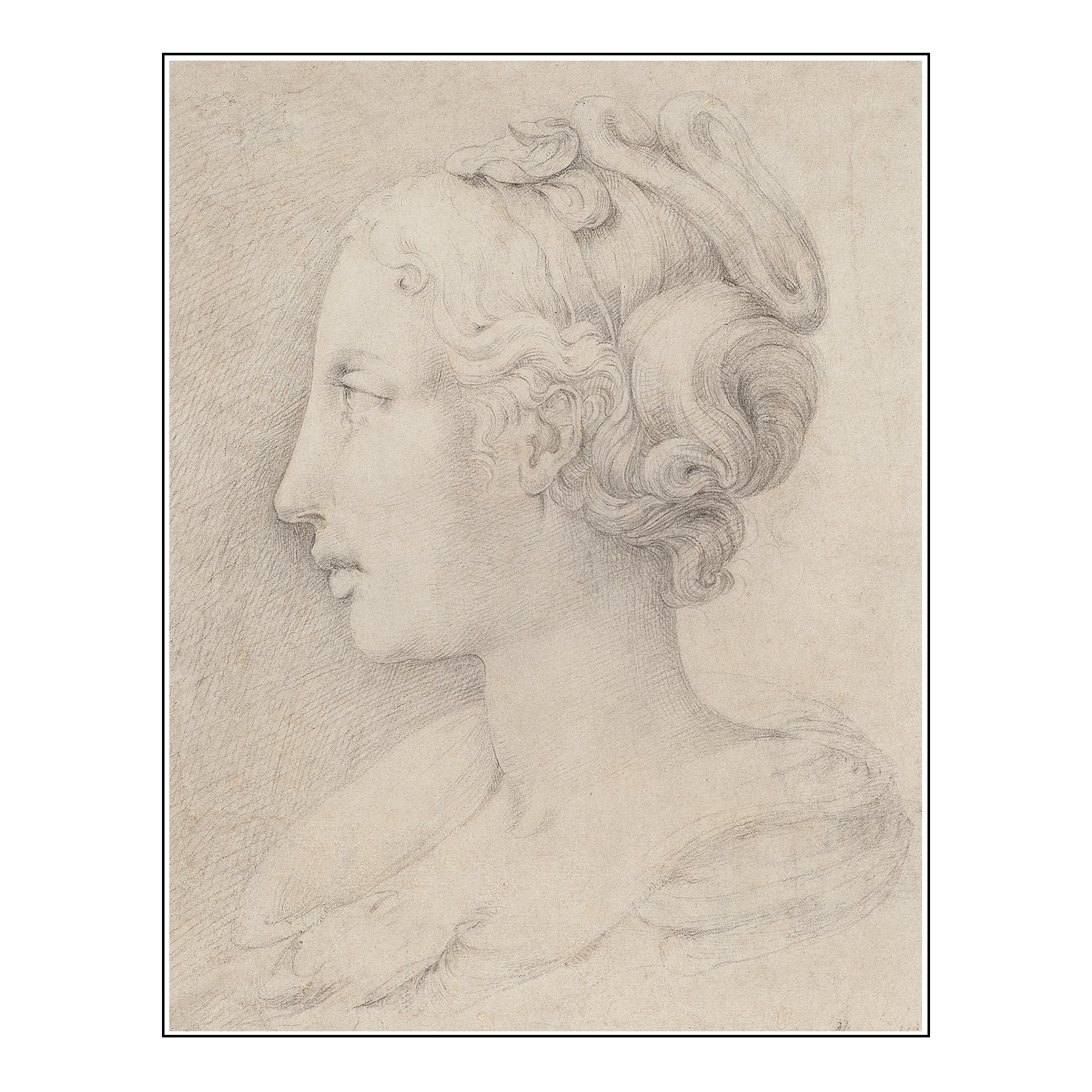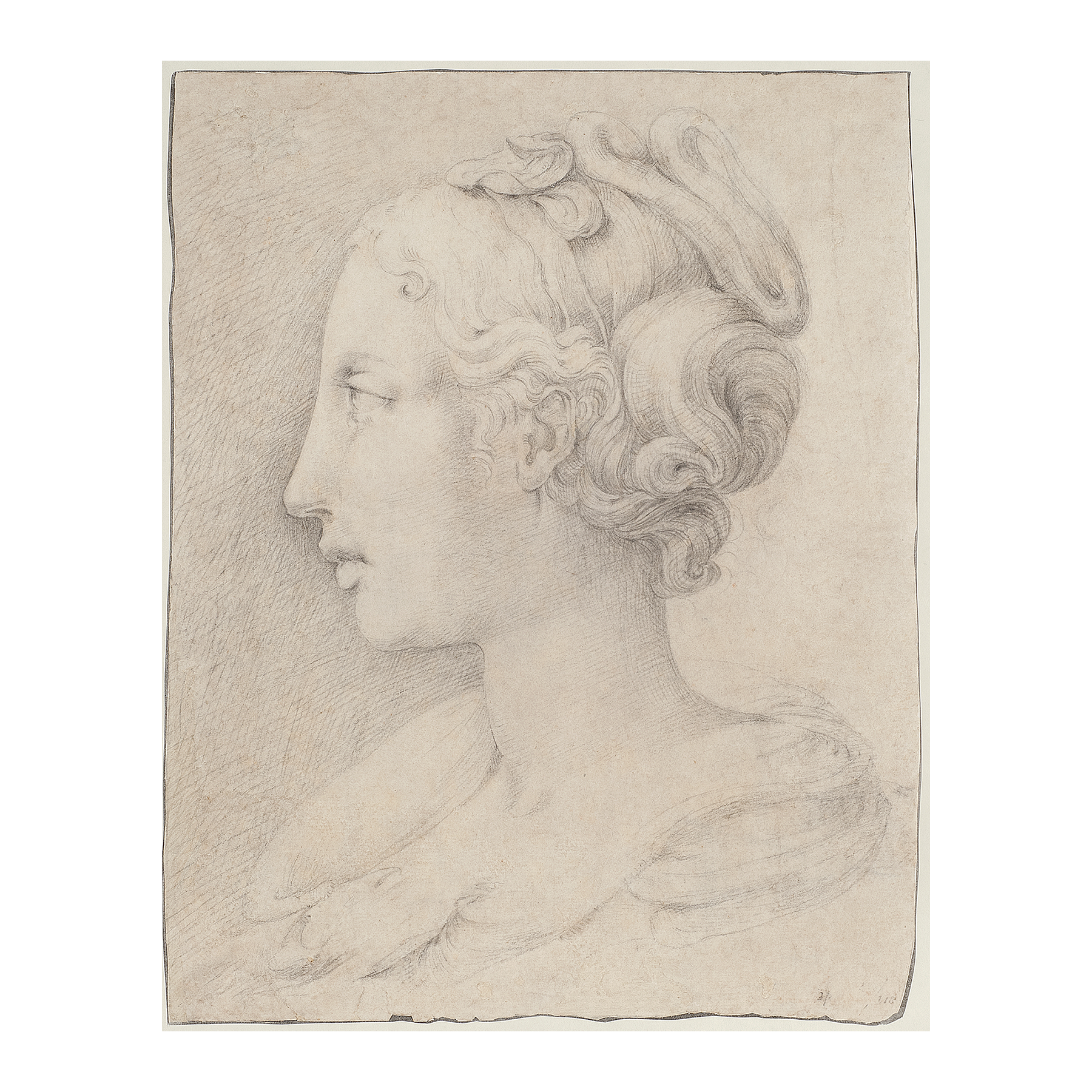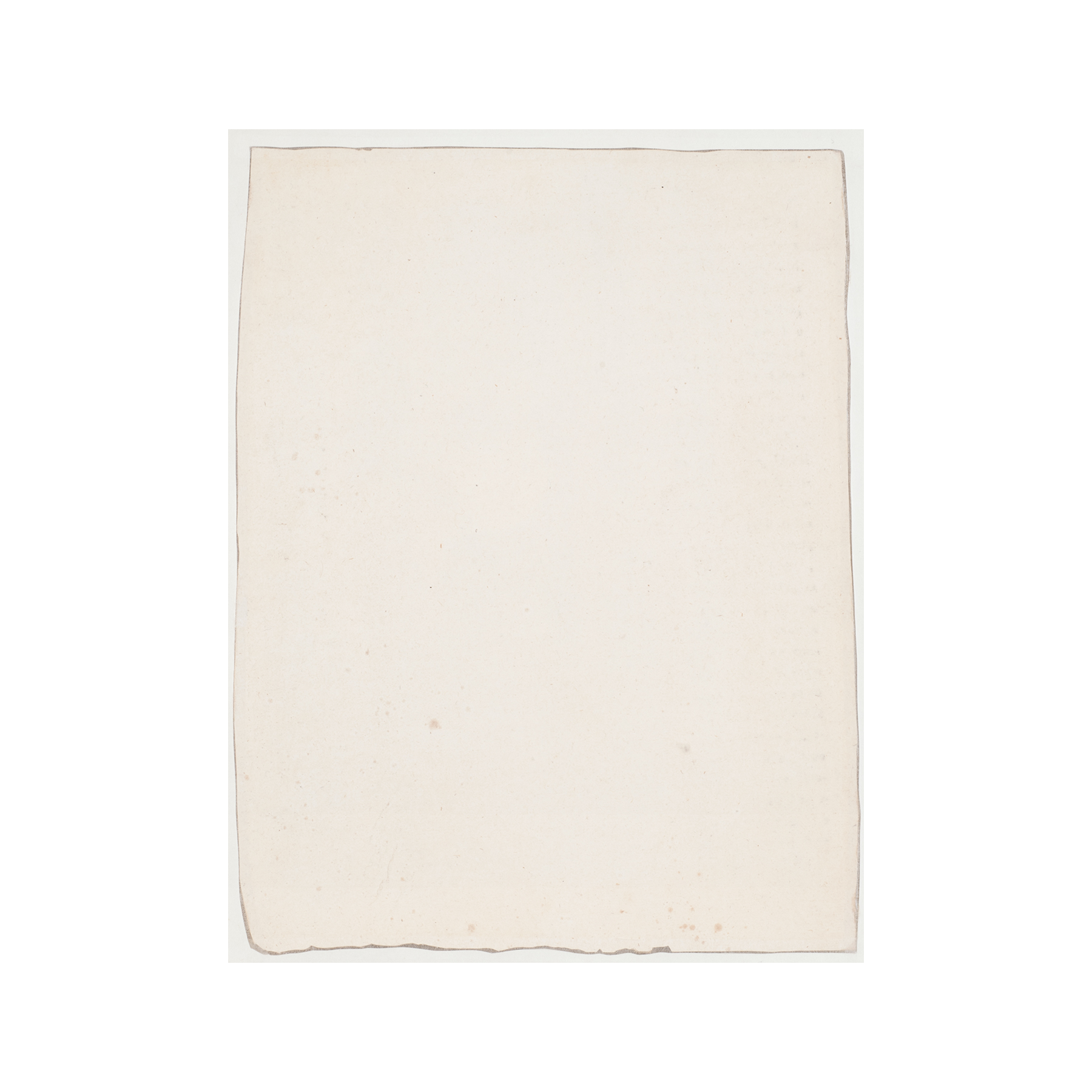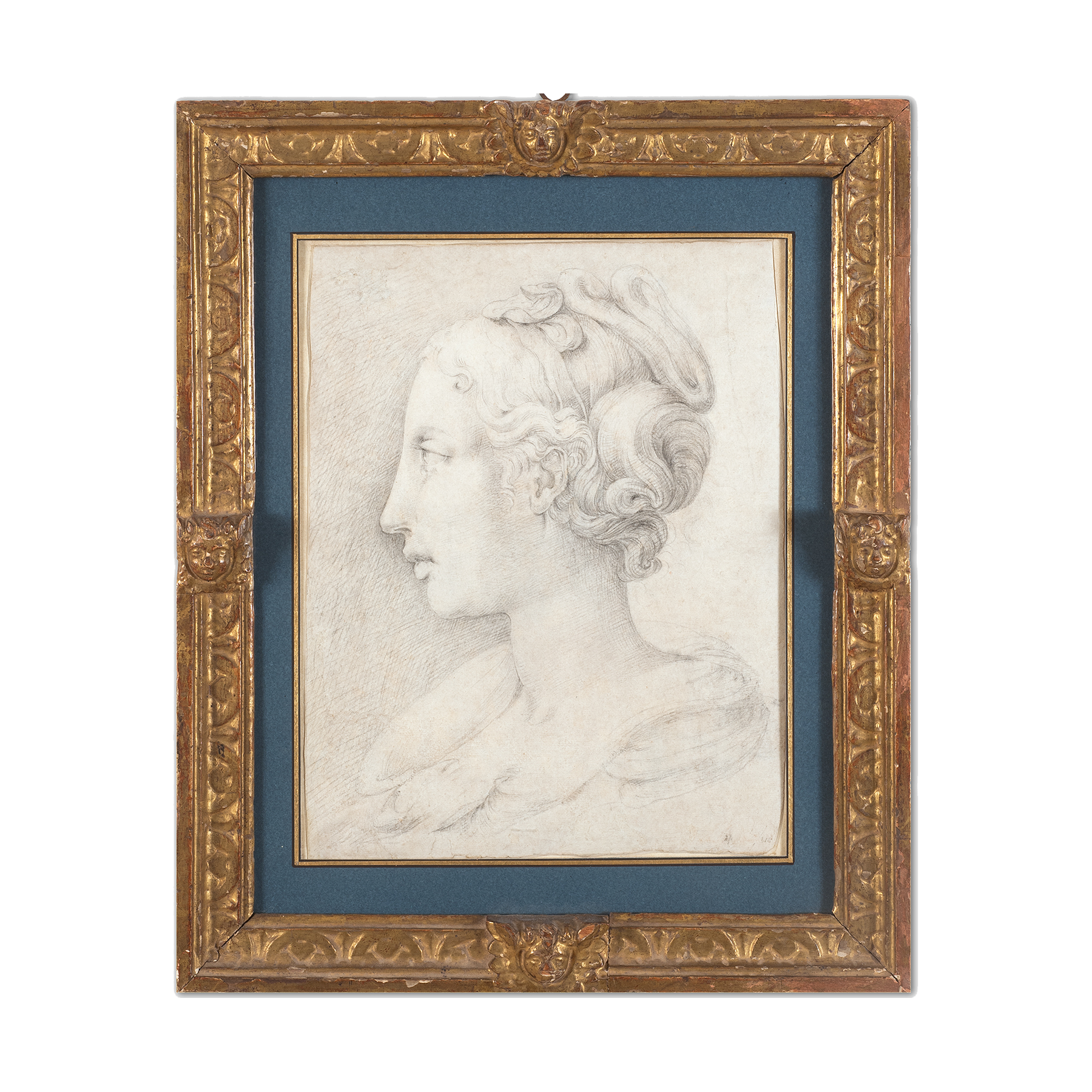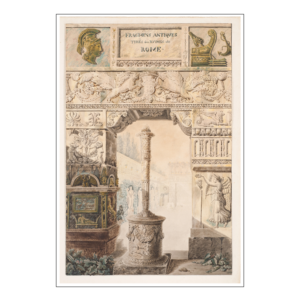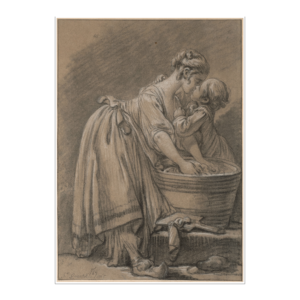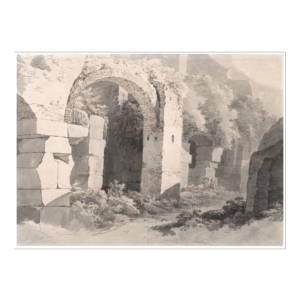Giulio Clovio
Grizane, Croatia 1498 – Rome 1578
Ideal Head, Woman in profile
Black chalk, inscribed Don Giulio miniatore on the verso
272 x 212 mm – 10 3/4 x 8 3/8 in.
Giulio Clovio was one of the most respected artists of his time and led a life rich in encounters and adventures. Our main source is the famous Florentine biographer Giorgio Vasari, who wrote that following his training under Girolamo dai Libri[1], the miniaturist was employed by Cardinals Grimani, then, for a short time, by Cardinal Campeggi. He later worked for Alessandro Farnese to the great annoyance of Cosimo I de Medici who continually tried in vain to make the artist work for him exclusively.[2] Mainly based in Rome, in the Farnese palace, Clovio travelled to Hungary, Mantua, Venice and Florence. He was a close friend of Giorgio Vasari and Francesco Salviati. It was in Clovio’s home that the former supposedly had an idea of his famous Vite, and it is with his help that the latter obtained the commission to decorate the chapel of the Palazzo San Giorgio. He also befriended Pieter Bruegel and Dürer and possessed works from both artists. The Portuguese artist and writer Francisco de Hollanda, whom Clovio had met in Rome, without hesitation granted him “the palm of victory over all illuminators in Europe”.[3] There is evidence of his connection with the Genovese Luca Cambiaso and Giovanni Battista Castello. Finally, he played a prominent role in the career of young El Greco, whom he recommended to Farnese when the artist came to Rome in 1570. In acknowledgement of his help, El Greco executed Clovio’s portrait, in which he represented the artist holding his most famous work, the Book of Hours that he illustrated for cardinal Farnese, today in the Museo di Capodimonte, Naples.
His oeuvre bears traces of this life rich in encounters: his style, which contributed to the widely disseminated movement of the Maniera, was enriched by all these influences. Thus, it is essential to be very cautious, as Catherine Goguel stated in 1988, in assigning works to Clovio’s graphic corpus,[4] which also concerns the present drawing. We have to admit that there are few sheets directly comparable to ours in terms of graphic style. The technique is wider here than in the majority of his securely attributed drawings that display a softer manner, the volumes treated with a very mellow black chalk. The Dead Christ supported by Saint John and wept over by the Holy Women (Paris, Louvre Museum, inv. 2819) and the Pieta (London, Victoria and Albert Museum, acc. N° DYCE 218) are one of a few that have the same network of curved and soft hatched lines, inspired by Parmigianino’s draughtsmanship.
Yet, our drawing can be reasonably compared to Clovio’s corpus by virtue of several important elements. First of all, the inscription don Giulio miniatore made by an ancient hand evokes certain familiarity with the artist. In fact, this is how his friends addressed to him or referred to him among themselves. Thus in a letter to Giorrgio Vasari dated 11 Novembre 1543[5] Don Miniato Pitti wrote: “Dite a don Giulio miniatore che e’ vitupera la corte …”. Or else, in the letter from his friends from the Accademia dello Sdegno, the poet Molza[6] or Trifone Benci mention “l’unico don Giulio miniatore”[7].
Moreover, the subject of this ideal head is comparable to the works of this type by Michelangelo whom Clovio, like others, often copied and imitated. However, its physical appearance rather draws inspiration in the virgins of Salviati, Vasari, and those, curved and slender, of Parmigianino. The three artists are known to have influenced the miniaturist’s career. Besides, his testament affirmed that he possessed several drawings by Parmigianino.[8] In addition, this profile of a woman is recurrent in his miniatures: among numerous examples, we can mention the Magdalen kneeling at the feet of Christ in the Lamentation (Washington, National Gallery, acc. N° 2006.11.1) and the female figure seated on the right in Death of Dido, in Stanze Eurialo d’Ascoli. Finally, the inventory of Fulvio Orsini recorded that the librarian and humanist possessed two heads “di maniera” in lapis nero by Giulio Clovio – probably his copies after Michelangelo’s ideal heads -, as well as other portraits, all in lapis nero, that is to say, graphite or thin black chalk. These drawings, considered very precious, were framed in ebony or walnut.
All these arguments allow us therefore to propose the attribution of this sheet to Clovio.
Condition report – False margins. Irregular edges. Thin paper laid down on a thicker paper. Vertical folding in the upper right corner. Paper compensation on the left edge (100x 10mm) and on lower edge, near the middle (40x 10mm). Small fills in the upper right part and in the upper left corner. The compensations are all on the edges and do not affect the composition nor the reading of the drawing.
[1] This precision appeared in the life of Fra Giocondo, Giorgio Vasari, Vite de’ piu eccellenti pittori scultori ed architettori, Firenze, Sansoni editore, 1880, vol. V, p. 330.
[2] Vasari, op. cit., vol. VII, “Vita di Don Giulio Clovio miniature”, p. 557-569.
[3] Francesco de Holanda, Dialogues de Rome, 1548.
[4] Catherine Goguel, “Giulio Clovio, nouveau petit Michel-Ange. A propos des dessins du Louvre.”, Revue de l’art, année 1988, vol. 80, No 1, p. 37-47. We would like to thank Catherine Goguel for her help and underline that although she does not dismiss an attribution to Giulio Clovio, she however expresses reservation as to the certainty of this attribution.
[5] Published in Kliemann, Giogio Vasari, Principi, letterati e artisti nelle carte di Giogio Vasari, Arezzo 1981, exhibition catalogue.
[6] Paul Oskar Kristteler, Iter italicum, London, The Warburg Institute, 1989, vol. 4, Allia II: letter in the Wroclaw University Library, cit. p. 438.
[7] Girolamo Tiraboschi, Storia della letteratura italiana, Naples, 1781, vol. II, parte prima, p. 119.
[8] A. Bertolotti, Don Giulio Clovio, principe dei miniatori, Florence Kunsthistoriche, 1883, p. 261 and 266.
